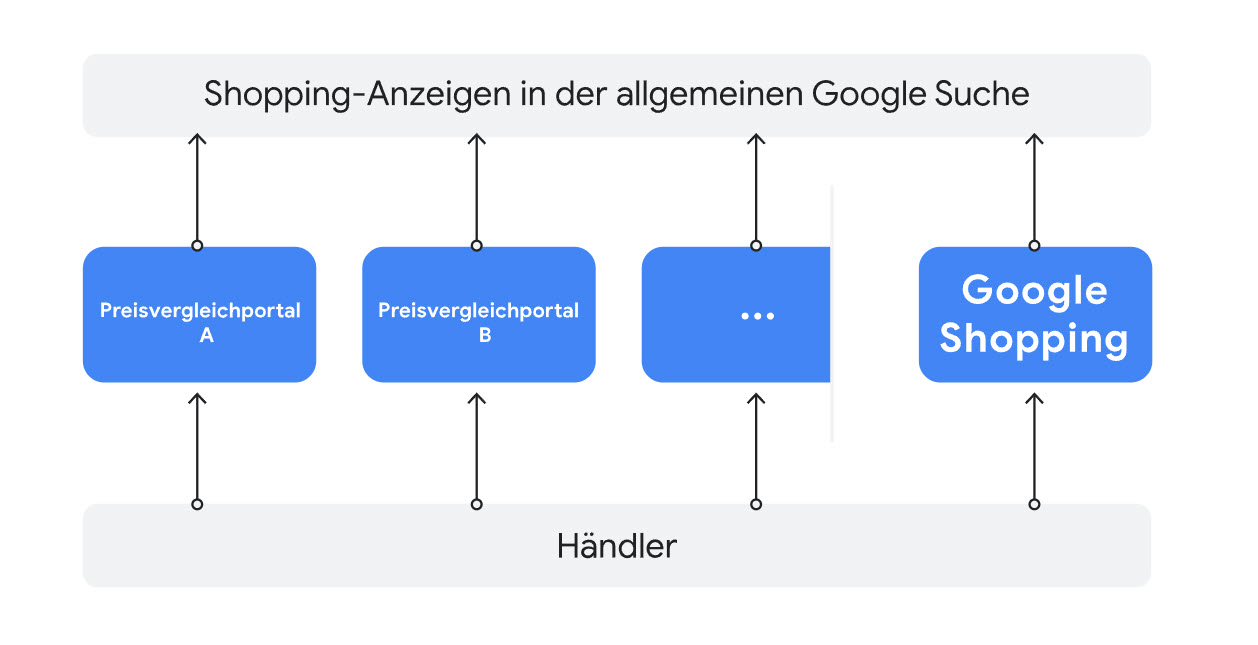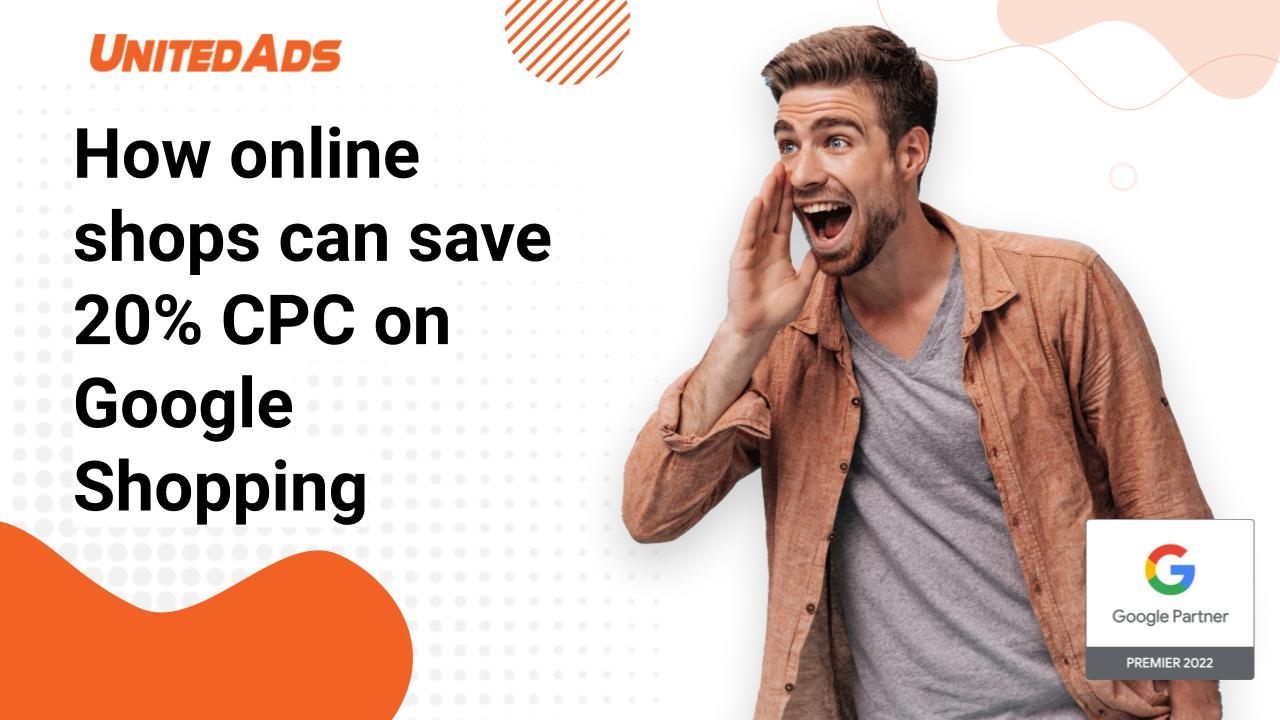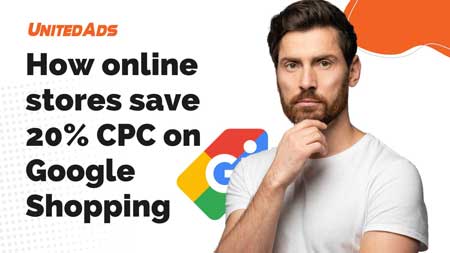Operators of price comparison portals in the European Economic Area (EEA) and Switzerland can place shopping ads on Google on behalf of merchants. The advantage for the merchant: 20% savings on the click prices.
In this article you will learn everything important about Google Shopping CSS.
[toc]
Google Shopping CSS represents the biggest change to Google Shopping in recent years. As CSS partners gain the benefit of a 20% margin advantage, it should be clear that more and more online retailers will rely on the Google Shopping CSS Ads topic in the future. As a result, the proportion of Google Shopping search results that are set by price comparison sites is likely to continue to rise over time.
As is so often the case in e-commerce, those who are quick and seize existing opportunities early will benefit. Those who become active with Google CSS now have the advantage of being able to outpace their own competitors thanks to the margin advantage of 20%.
What is Google Shopping CSS?

Google Shopping CSS is a way to display shopping ads. CSS stands for Comparison Shopping Services and concerns the main search on the Google homepage. The introduction of Google Shopping CSS became necessary because Google was using the search results page exclusively for its own offer: Google Shopping. Other price comparisons (Comparison Shopping Services) only appeared much further down in the search results. The European Commission found this to be unfair competition.
In order to create a level playing field, Google rebranded the ad platform as Google Shopping Europe (GSE) and opened it up to external price comparison sites, the Google CSS partners. The result: for some time now, all Shopping ads that appear in Google’s main search results have been part of a Comparison Shopping Service (CSS).
Google Shopping itself also acts as a CSS (“From Google”), participates in the bidding auction like the other price comparison platforms, and competes with other CSSs that place bids on behalf of merchants. However, in order to use its own price comparison in an EU-compliant manner, Google retains around 20% of your maxCPC bid as a margin. This means that your bids will always be reduced by about 20% if you leave them with Google Shopping Europe. If you use a CSS partner for your ads, the margin does not apply at all.
For Google users the difference is hardly noticeable, the only visible change is the added line “From ….” at the bottom of the ad.
Why did Google Shoppping CSS become necessary?
The EU Commission’s accusation: Competition in the price comparison markets was restricted by the Google Shopping service. Google had exploited its monopoly position as a search engine by ranking its own Shopping ads disproportionately favorably. In plain language, this means that if a consumer is interested in a particular product and searches for it via the Google search engine, it is noticeable that Google Shopping ads are much more visible in the search results than other price comparison services. Google thus gives its own price comparison service a considerable advantage by placing its competitors in a worse position.
According to the Commission’s ruling, operators of price comparison portals in the European Economic Area (EEA) and Switzerland can place Shopping ads on Google on behalf of merchants.
Etwa 20% niedrigere CPCs mit Google Shopping CSS
Bei UnitedAds geben wir die Marge, die Google den Preisvergleichen gutschreibt komplett an unsere Kunden weiter. Das bedeutet für Sie: Mit UnitedAds als Google CSS Partner verursachen Ihre Klickkosten bei Google Shopping rund 20% geringere Kosten.
D.h. in Klartext Ihre Kosten für Google Shopping werden um 20% sinken oder Sie erhalten für das gleiche Budget 20% mehr Klick.
Dies gilt jedoch nur für die Ausspielung der Anzeigen auf der Startseite der Google Suche: Die “Shopping”-Seite wird aus Sicht der Europäischen Kommission als alleinstehender Preisvergleich gewertet und ist daher nicht vom Urteil betroffen.
Was hat sich durch Google Shopping CSS geändert?
Für Google Nutzer ist die Einführung von Google Shopping CSS kaum erkenntlich – die vorerst einzige sichtbare Änderung war die hinzugefügte Zeile “Von ….” am unteren Rand der Anzeige. Inzwischen hat Google eine eigenes Anzeigenformat für CSS gestartet: die Comparison Listing Ads. Sie weisen neben den normalen Shopping Ads ein zweites Karussell vor, in dem alle relevanten Preisvergleiche hervorgehoben werden.
Advertiser ist der Preis eines Klicks natürlich die entscheidende Änderung durch Google Shopping CSS. Genauer gesagt, hat sich die Zusammensetzung der Händler-Gebote in Google Shopping geändert. Google Shopping behält etwa 20% der Gebote als Marge ein. Das bedeutet für Sie als Händler, dass Ihre Gebote um etwa 20% reduziert in die Auktion um den Anzeigenrang eingehen! Sie sind also plötzlich massiv im Nachteil gegenüber Werbetreibenden, die ihre Google Shopping Ads bereits über einen Google CSS Partner schalten.
Ein Beispiel
Angenommen, Sie geben ein maxCPC-Gebot von 1€ ab. Nutzt Sie noch keinen CSS, sondern weiterhin Google Shopping Europe (GSE), werden davon 0,20€ abgezogen. Die Folge: Sie gehen mit dem reduzierten Gebot von 0,80€ in die Auktion.
Bewerben Sie Ihre Produkte nicht über GSE, sondern über einen anderen Google CSS Partner, fällt diese Marge weg. Deine Gebote gehen in voller Höhe, also mit 1€, in die Auktion ein. Der Vorteil: Sie gewinnen mit gleichem maxCPC-Gebot deutlich mehr Auktionen und können Ihren Traffic deutlich erhöhen oder die Kosten reduzieren.
Google Shopping CSS Integration: Full Switch oder Association
Um Google Shopping Anzeigen über einen CSS-Partner auszuspielen gibt es zwei Möglichkeiten, um ein bisheriges GSE-Konto auf CSS umzustellen. Advertiser müssen sich zwischen Full Switch und dem Modell Association entscheiden.
Beim Full Switch wird der Merchant Center Account (MCA) eines Advertisers voll in das Multi Client Merchant Center (MCC) des CSS-Partners integriert. Bei diesem Umzug sind einige technische Aspekte zu beachten. Wenn nicht das komplette MCA, sondern nur ein Subkonto umgezogen wird, kann es beispielsweise sein, dass die Zugriffsrechte beim Umzug verloren gehen. Positiv ist beim Full Switch, dass der CSS-Partner Einblick in die Produktdaten hat, Ursachen für Probleme selbst erkennen kann und die Transparenz bei einem prozentualen Vergütungsmodell gegeben ist. Die Abhängigkeit des Advertisers vom CSS-Partner ist jedoch höher als bei der einfachen Verknüpfung nach dem Association Modell und erfordert Vertrauen zwischen beiden Parteien.
Wählt ein Advertiser das Association Modell, wird sein MCA relativ unkompliziert mit dem CSS-Partner verknüpft. Das Setting des Advertisers kann in diesem Fall unverändert bleiben, der Umzugsaufwand ist minimal – genau genommen reicht eine Mail des CSS-Partners an Google, in der die Umstellung beantragt wird. Wenn lediglich ein Subkonto aus einem MCA umgestellt wird, gelten dieselben Gefahren vom Verlust der Zugriffsrechte, wie beim Full Switch. Die eben genannten Vorteile der Full Switch Methode (voller Zugriff und Einsicht in die Produktdaten durch den CSS-Partner) kommen hier nicht auf Anhieb zum Tragen. Über entsprechende Nutzereinladungen oder das Einrichten einer API-Schnittstelle kann dem CSS-Partner jedoch Zugang zum Kundenkonto bzw. Datenfeed verschafft werden.
Im Handling und der Zusammenarbeit unterscheiden sich Full Switch und Association kaum. Es ist eher eine Frage des Vertrauens, der Kontrolle und Flexibilität, ob ein Advertiser sein gesamtes Konto in das MCC des CSS-Partnes umzieht, oder über Association „andockt“. Eine weitere Methode ist die Einrichtung eines CSS Subaccounts: Die direkte Eröffnung eines Unterkontos bei einem CSS-Preisvergleicher bietet sich an, wenn man mit mehr als nur einem CSS-Preisvergleicher zusammenarbeiten möchte. Dafür ist keine Verifizierung seitens Google erforderlich. Trotzdem müssen die Produktlinks auf die im Subaccount hinterlegte Zieladresse im Webshop führen.
So können Sie Google Shopping CSS für ihren Shop nutzen
Wenn sie CSS über UnitedAds als Google CSS Partner nutzen möchten, übernehmen wir die gesamten Formalitäten. Wir stellen für Sie einen Antrag für die Freischaltung Ihres Merchant Center Accounts (MCA).
Für Sie entsteht dadurch praktisch kein Migrations-Aufwand – alles bleibt beim Alten. Sie können sofort weiterarbeiten, ohne Umzugsstress und Umgewöhungsphasen.
Lohnt sich der Wechsel zu einem Google CSS Partner?
Bei minimalem Aufwand reduzieren sich ihre Klickkosten um 20%. Damit lohnt sich der Wechsel zu einem CSS Partner für jeden Onlineshop, der mehr als rund €1.000 Budget in den Marketingkanal Google Shopping investiert.
War die Lebensdauer von Google Shopping CSS zu Beginn des Programms noch unklar, spricht inzwischen vieles dafür, dass es fester Bestandteil von Google Shopping bleben wird. Der Druck der EU auf Google nimmt weiterhin zu. Die Tatsache, dass Google Shopping Europe immer noch deutlich häufiger in den Suchergebnissen vertreten ist als CSS Partner zeigt, dass es immer noch Luft nach oben gibt. Google wird also andere Preisvergleiche weiterhin zur Präsenz in den Shopping Anzeigen zu motivieren. Das tut Google zum Beispiel, in dem es Formate wie Comparison Listing Ads (CLA) entwickelt, die speziell für Google Shopping CSS Partner gedacht sind.
Wer aufgrund von Unsicherheit nach wie vor auf Google Shopping Europe setzt, sollte sich spätestens jetzt mit CSS auseinandersetzen. Die Häufigkeit und Kurzfristigkeit, mit der Google über Änderungen des CSS Programms informiert, bleibt allerdings eine Herausforderung. Es ist Eigeninitiative und Weitsicht auf Seiten von CSS-Anbietern und Advertisern gefragt, um mit Google Shopping CSS in Zukunft erfolgreich zu sein.
Doppelstrategie Google Shopping Europe und Google Shopping CSS
CSS-Shopping eröffnete Advertisern neue strategische Spielwiesen. Unternehmen standen vor der Entscheidung, ihr gesamtes Budget auf CSS-Shopping zu verschieben, GSE und CSS parallel zu bespielen oder ganz auf CSS zu verzichten.
Nach wievor nutzen viele Onlineshops nicht die Vorteile von CSS. Das liegt vermutlich vor allem an den vielen kleineren Händlern, für die sich die CSS-Nutzung nicht lohnt, weil CSS-Fixkosten die vom Mediaspend abhängigen Einsparungen übertreffen. Einige Advertiser betreiben aber auch parallele Kampagnen über CSS und GSE. Der Nachteil an dieser hybriden Strategie ist, dass die identischen Kampagnen in zwei verschiedenen Google-Ads-Konten gepflegt werden müssen.
Eine allgemein gültige Empfehlung gibt es nicht. Der Nutzen von CSS-Shopping hängt nicht nur von der Höhe des Geldeinsatzes, sondern auch von der Strategie des Werbetreibenden ab. Wer zum Beispiel seine Wettbewerber verdrängen will, kann seine Anzeigen über GSE und mehrere CSS gleichzeitig in die Auktion einspeisen und so einen hohen Werbedruck erzeugen. Wer hingegen auf Effizienz optimiert, sollte ausschließlich auf CSS setzen.






